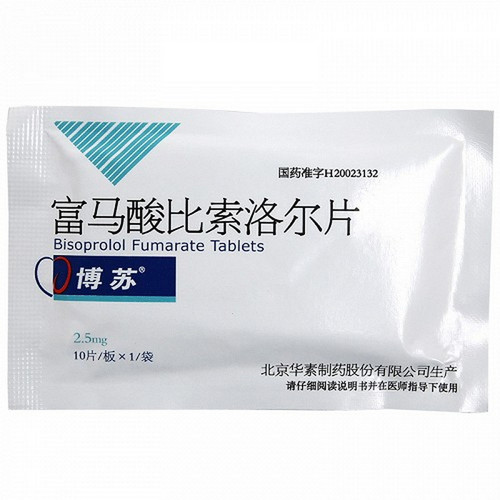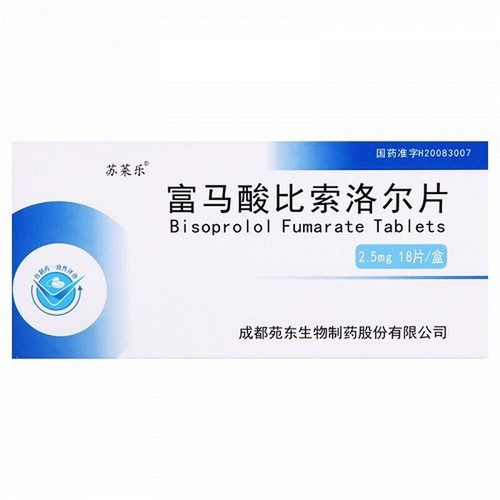Product Overview
[Drug Name]
Generic Name: Bisoprolol Fumarate Tablets
Trade Name: Kangxin Bisoprolol Fumarate Tablets 5mg*10 Tablets
Pinyin Code: KangXin FuMaSuanBiSuoLuoErPian 5mg*10 Tablets
[Main Ingredient]
Bisoprolol Fumarate.
[Properties]
This product is a white tablet.
[Indications/Main Functions]
Hypertension, coronary heart disease (angina pectoris), chronic stable heart failure; see package insert for details.
[Precautions]
1. Use with caution in patients with diabetes and acidosis who experience significant blood sugar fluctuations. 2. Use with caution in patients with pulmonary insufficiency or severe hepatic or renal insufficiency. 3. When discontinuing treatment, the dose should be gradually reduced daily. A dose reduction is often required when used in combination with other antihypertensive medications. 4. Due to the antihypertensive effect of Kangxin Bisoprolol Fumarate Tablets, the patient's ability to drive or operate machinery may be impaired, especially when first taking the drug, when switching medications, or when taken with alcohol. However, this does not directly affect a person's reaction time. 5. Athletes should use with caution.
[Drug Interactions]
1. Myocardial insufficiency (decompensated heart failure), new myocardial infarction, shock, atrioventricular conduction disorders (second- and third-degree atrioventricular block), sick sinus syndrome, sinoatrial block, bradycardia (less than 50 beats per minute), hypotension, bronchial asthma, and late-stage peripheral circulatory disorders. 2. Adrenal adenoma (pheochromocytoma): Bisoprolol Fumarate Tablets should only be taken after taking an alpha-blocker. 3. This product should not be used by pregnant women, children, or breastfeeding women.
[Pediatric Use]
There is no experience with the use of bisoprolol in pediatric patients, so this product is not recommended for use in children.
[Elderly Use]
No dose adjustment is required.
[Use During Pregnancy and Lactation]
Pregnancy: Bisoprolol may harm the mother and/or fetus/neonatal. In general, beta-adrenergic receptor antagonists can reduce placental perfusion, which is associated with growth retardation, intrauterine death, resorption, and preterm birth. Adverse reactions such as hypoglycemia and bradycardia may occur in the fetus and neonate. If a beta-adrenergic receptor blocker is necessary, a selective beta-1-adrenergic receptor blocker is ideal. Bisoprolol should not be used in pregnant women unless clearly indicated. If bisoprolol treatment is necessary, uteroplacental blood flow and fetal growth should be monitored. If adverse effects on the mother or fetus are detected, alternative treatment options should be considered. Neonates must be closely monitored; symptoms such as hypoglycemia and bradycardia are most likely to occur in the first three days of life. Lactating Women: It is unknown whether this drug is excreted in human milk. Therefore, bisoprolol treatment is not recommended for lactating women.
[Specifications]
5mg*10 tablets
[Dosage and Administration]
Oral administration once daily. Initial dose: 2.5mg. Maximum daily dose: 10mg. Please follow your doctor's instructions.
[Adverse Reactions]
1. Mild fatigue, chest tightness, dizziness, bradycardia, drowsiness, palpitations, headache, and lower limb edema may occur initially, but these symptoms will subside or disappear spontaneously with continued medication. 2. In rare cases, gastrointestinal disturbances (diarrhea, constipation, nausea, abdominal pain) and skin reactions (such as erythema and itching) may occur. 3. A significant decrease in blood pressure, slow pulse, or atrioventricular conduction disturbances may occasionally occur. 4. Tingling or cold extremities may occur. In rare cases, muscle weakness, muscle cramps, and decreased tearing may occur. 5. In patients with intermittent claudication or Raynaud's phenomenon, symptoms may worsen in the initial treatment period. Preexisting myocardial insufficiency may also worsen symptoms. 6. Increased airway resistance may occasionally occur. 7. For elderly patients with diabetes, glucose tolerance may be impaired, masking the symptoms of hypoglycemia (such as tachycardia).
[Contraindications]
1. Myocardial insufficiency (decompensated heart failure), recent myocardial infarction, shock, atrioventricular conduction disorders (second- and third-degree atrioventricular block), sick sinus syndrome, sinoatrial block, bradycardia (less than 50 rpm), hypotension, bronchial asthma, and advanced peripheral circulatory disorders. 2. Adrenal adenoma (pheochromocytoma): Bisoprolol fumarate tablets should only be taken after taking an alpha-blocker. 3. This product should not be taken by pregnant women, children, or breastfeeding women.
[Overdose]
The most common overdose reactions of beta-adrenergic receptor blockers are bradycardia, hypotension, bronchial asthma, acute heart failure, and hypoglycemia. Individual sensitivity to a single high dose of bisoprolol varies widely, and patients with heart failure may be particularly sensitive. Overdose usually occurs and should be promptly discontinued with supportive symptomatic treatment. Limited data suggest that bisoprolol is difficult to dialyze. Based on the expected pharmacological effects and experience with other beta-blockers, the following management options may be considered when clinically indicated: Bradycardia: Intravenous atropine. If inadequate, isoproterenol or other positive chronotropic agents may be cautiously administered. In some cases, an intravenous pacemaker may be necessary. Hypotension: Intravenous fluid replacement and vasopressor medications should be administered; intravenous glucagon may be helpful. Atrioventricular block (second or third degree): The patient should be carefully monitored, and appropriate intravenous isoproterenol or an intravenous pacemaker may be administered. Exacerbation of acute heart failure: Intravenous diuretics, inotropes, and vasodilators may be administered. Bronchospasm: Treatment with bronchodilators such as isoproterenol, β2-sympathomimetics, and/or aminophylline. Hypoglycemia: Intravenous glucose.
[Pharmacology and Toxicology]
Pharmacological Action: Bisoprolol is a highly selective β1-adrenergic receptor blocker (cardioselective) with no intrinsic sympathomimetic or membrane-stabilizing activity within the therapeutic dose range. Bisoprolol fumarate also inhibits β2-adrenergic receptors on bronchial and vascular smooth muscle at supratherapeutic doses (≥20 mg). Therefore, it is important to use the lowest effective dose to maintain high cardiac selectivity. Toxicological Studies: Genotoxicity: Bisoprolol showed negative results in the Ames test, Chinese hamster V79 cell gene mutation and chromosome aberration assays, DNA damage assays, rat cytogenetic assays, and mouse micronucleus assays. Reproductive Toxicity: No significant effects on fertility or early embryonic development were observed in rats when administered orally at doses of 150 mg/kg/day. This dose is 77 times the maximum recommended daily dose (MRHD) in humans (based on body surface area). In embryo-fetal toxicity studies, oral administration of bisoprolol fumarate at 50 mg/kg/day to pregnant rats increased the incidence of embryonic resorptions, a dose 26 times the MRHD. Maternal toxicity (reduced food intake and suppressed weight gain) was observed at a dose of 150 mg/kg/day, 77 times the MRHD. Oral administration of bisoprolol fumarate to pregnant rabbits at doses up to 12.5 mg/kg/day increased early embryonic resorption rates, but no fetal toxicity was observed. This dose is 12 times the MRHD. Carcinogenicity: Oral administration of bisoprolol fumarate to mice at doses of 250 mg/kg/day for 20 and 24 months, and to rats at doses of 125 mg/kg/day for 26 months, did not result in drug-related carcinogenicity. These doses, calculated based on body surface area, are 59 and 64 times the MRHD, respectively.
[Pharmacokinetics]
Bisoprolol is almost completely absorbed from the gastrointestinal tract (>90%). Due to minimal first-pass absorption by the liver (<10%), it exhibits a bioavailability of approximately 90%. Bisoprolol has a plasma protein binding rate of approximately 30%, a volume of distribution of 3.5 L/kg, and a total clearance of approximately 15 L/hour. Following once-daily dosing, its plasma half-life is 10-12 hours, and it remains in plasma for 24 hours. Bisoprolol is excreted from the body via two pathways: 50% is metabolized by the liver to inactive metabolites that are then excreted by the kidneys, while the remaining 50% is excreted unchanged by the kidneys. Because the drug is eliminated equally by the kidneys and liver, no dose adjustment is required in patients with mild to moderate hepatic or renal dysfunction. The pharmacokinetics of bisoprolol have not been studied in patients with chronic stable heart failure and impaired liver or renal function. The kinetics of bisoprolol are linear and independent of age. Compared with healthy volunteers, patients with chronic heart failure (NYHA class III) have higher plasma bisoprolol levels and a prolonged half-life. After daily oral administration of 10 mg, the maximum plasma concentration at steady state is 64±21 ng/ml, and the half-life is 17±5 hours.






